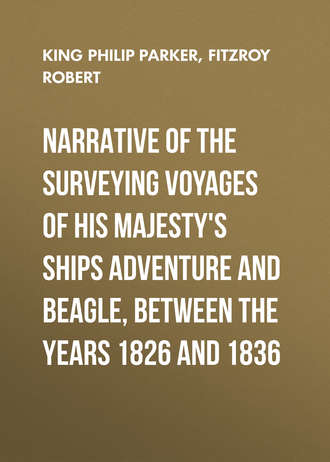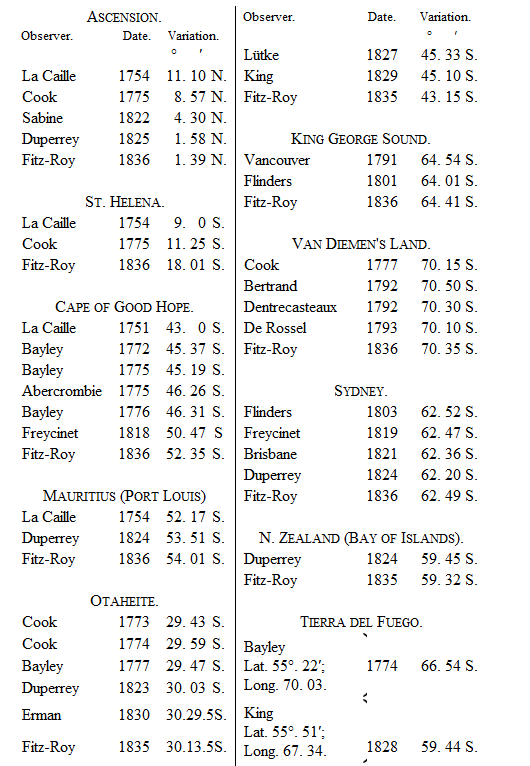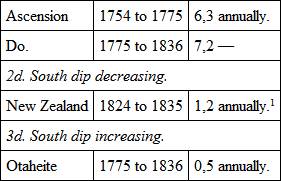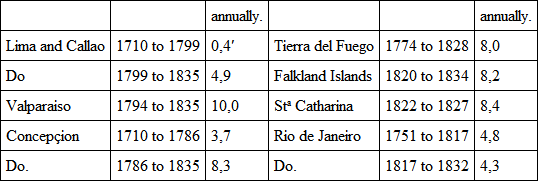 полная версия
полная версияNarrative of the surveying voyages of His Majesty's ships Adventure and Beagle, between the years 1826 and 1836
1. Variation
Captain Fitz-Roy's observations are so well distributed over the southern hemisphere, that a good view of the changes which the variation is undergoing throughout its meridians may be obtained by comparing his determinations with those of earlier observers at the same stations. The following table has been formed for the purpose of exhibiting such a comparison at all those stations where materials for it exist; and I may here remark how much such comparisons are facilitated by the valuable collection of early observations contained in the Appendix to the Magnetismus der Erde.

We may derive from the facts in the above table the following general and easily remembered conclusion in regard to the changes of the variation in the southern hemisphere; namely, that taking for our point of departure the meridian of 65° west in South America, we find that at all the stations east of that meridian to the Cape of Good Hope inclusive, the north pole of the needle has moved towards the west; and that all the stations west of the same meridian to Mauritius inclusive, the north pole of the needle has moved towards the east.
An almost equally simple generalization may be drawn in respect to the changes of situation of the lines of equal variation in the southern hemisphere: but here it must be supposed either that the reader is thoroughly familiar with the general arrangement of these lines, or that he has a map of them before him. He will find such a map of the variation lines in 1787 in the Fifth Report of the British Association; but any other map, corresponding to any epoch within the last hundred years, will equally serve the purpose. Referring to such a map, it will be seen that the lines of variation in the South Pacific, form a system of nearly concentric curves, of an oval, or pear-shaped form, the outside curves having a higher variation, which progressively diminishes to the centre. We may regard this system as comprehending the whole of the geographical space between the coast of South America and the meridian of New Zealand. Throughout this space the variation is easterly, and increases: we may consequently characterize the change in the situation of the lines of equal variation as a progressive closing-in of the curves from all sides towards the centre, by which the areas severally comprehended by them become less; and the lower variations, as they successively reach the centre, disappear, and are replaced by the closing-in of those of next higher amount. The changes which have taken place at all Captain Fitz-Roy's stations comprised within the space referred to, are accordant with the systematic alteration thus described.
In all other parts of the hemisphere the lines of variation have a progressive westerly movement, and to this also Captain Fitz-Roy's observations correspond.
It follows, from what has been stated, that the lines on the western side of the concentric system in the South Pacific have an eastward movement, which presents an apparent anomaly to the general progress of the lines of variation in the southern hemisphere, which is from east to west.
Otaheite, and the Bay of Islands in New Zealand, present examples of changes in the variation corresponding to this apparent anomaly. The consistency, however, both of the movement and of the configuration of the lines of variation in this quarter, with those in other parts of the southern hemisphere, and with the general system of the magnetic phenomena, has been shewn by Mr. Hansteen in the Magnetismus der Erde, and in the Annalen der Physik, vol. xxi.
The annual amount of the change of the variation appears considerably greater at the Cape of Good Hope and Mauritius than at any other of Captain Fitz-Roy's stations, amounting to about eight minutes; shewing that the variation lines in that quarter are changing their position more rapidly than elsewhere. The north pole of the needle is moving to the west at the Cape, and to the east at Mauritius; but it will be seen, by a reference to the map, that these opposite movements are in perfect correspondence with the uniform westerly progression of the variation lines, and result from their configuration.
At the stations in the vicinity of the meridian of 65° west, the change appears to be very small.
[The variation at Ascension (13° 30′ W.) is correctly inserted in the tables: it is the only one of Captain Fitz-Roy's stations at which his observations are not accordant with those of other observers: the discordance may be occasioned by the great prevalence of local disturbances at Ascension.]
II. DipThe following table exhibits the comparison of Captain Fitz-Roy's observations of the dip in the southern hemisphere, with those of earlier observers, at stations where the materials for such a comparison exist.


We may classify the changes which are taking place in the dip in the southern hemisphere in four divisions, characterised by an alternate increase and decrease of dip. Commencing with the meridian of Greenwich, and proceeding eastwardly round the hemisphere, we may distinguish the divisions as follows, in the order of their geographical succession.
1st. South dip increasing
To this division also belongs Ascension; but as the north end of the needle dips at that island, the change is north dip diminishing, instead of south dip increasing.

1This is derived from the observations of Captains Duperrey and Fitz-Roy at the Bay of Islands, in Lat. 35°. 16′. The interval is short; but the indication receives confirmation from the observations of Captains Cook and Vancouver at Dusky Bay, New Zealand, in Lat. 45°. 47′.
4th. South dip decreasing

In the 2d and 3d divisions the annual change is small; in the 1st and 4th considerably greater. It is greatest at the southern station in South America; the observations at Valparaiso, Concepçion, Tierra del Fuego, and the Falkland Islands, concur in shewing it to exceed 8′. The observations at Ascension, St. Helena, and the Cape of Good Hope, concur in shewing an annual change in that quarter of the 1st division exceeding 6′.
As the south dip decreases in South America, and increases in Africa, it is obvious that somewhere intermediately the dip must be stationary. Between Africa and New Zealand, for the same reason, there must be a second locality so characterised. Between New Zealand and Otaheite, a third; and between Otaheite and the west coast of South America, a fourth. Captain Fitz-Roy has stations in the second of these localities only, between Africa and New Zealand. At Hobart Town, Sydney, and King George Sound, there appears to have been little or no change in the dip since the commencement of the present century.
The arrangement of the changes of dip in the southern hemisphere in four divisions, characterised by an alternate increase and decrease of dip, is in correspondence with the double flexure of the lines of dip; and is a consequence of the western motion of the two southern magnetic poles.
Careful observations made at St. Petersburgh, have shewn that the annual change of the dip in the northern hemisphere takes place altogether between the months of May and December; there being in fact a small movement in an opposite direction between December and May. This fact is of great interest in its bearing on the study of the causes of the magnetic phenomena. We have as yet no corresponding knowledge in regard to the southern hemisphere. The magnitude of the annual change which Captain Fitz-Roy's observations show is now taking place at the Cape of Good Hope, is deserving of attention in this respect. A large amount of annual change is obviously highly favourable for a determination of all the circumstances belonging to it; and its existence at the Cape, where there is already a fixed observatory, points to that station as most eligible for this investigation.
The observations at Ascension shew that the epoch is fast approaching when the needle will pass from north to south dip at that island: it is extremely desirable that the period at which this change takes place should be determined with as much precision as possible.
III. IntensityI have discussed in the Seventh Report of the British Association, the very important inferences in regard to the general distribution of magnetism in the southern hemisphere, afforded by Captains King and Fitz-Roy's most valuable series of intensity observations; but no inferences in regard to the changes which this phenomenon may be supposed to undergo can be drawn, as has been done in the cases of the variation and dip, because we possess no observations of the intensity made at a sufficiently early period to afford good materials for such a comparison.
EDWARD SABINE.
Catalogue of the more interesting Specimens of Natural History that were collected during the voyage—MAMMALIA1. Mustela Zorilla. Desm:241The skunk. This animal was found abundantly on the coast of Patagonia, between Monte Video and Cape Gregory, at the eastern entrance of the Strait of Magalhaens. It appeared to be the same species throughout the whole extent of the coast. – Mus. Zool. Soc.
2. Mustela lutris. – LinLutra marina, Steller. Erxleb. Harlan; Enhydra marina, Fleming.
The sea otter exists, but not very plentifully, on the coast of Tierra del Fuego; we saw very few. The Fuegian Indians hunt them with dogs which are trained for the purpose. – Museum Zool. Soc.
3. CanisThe dogs belonging to the Fuegian Indians are certainly of the domesticated kind, originally obtained, probably, from the Spanish settlements at Buenos Ayres; generally they resemble the Esquimaux breed, but are much more diminutive in size.
4. Canis VulpesTwo if not three distinct species of the fox were brought home; one, of a small size, was thought to be a novelty; the other, perhaps, was only remarkable for its large size. Mr. Vigors thought the small one was quite new; the last is perhaps C. cinereo argenteus. – Museum of Zool. Soc.
5. Felis pumaSeveral were seen: a skeleton was found on the shores of the Strait, supposed to be one of the above species.
6. Felis pajeros. – Desm. E. M. p. 231Chat pampa, D'Azara, 1. 179.
A variety of this species was given to me, by the Patagonian Indians, that had been recently killed; the skin was preserved, and is now in the museum of the Zoological Society. The following is the description of my specimen: —
The prevailing colour is a yellowish grey, deeper above, and gradually blending into the colour of the belly, chin, neck, inner part of the legs, the region of the anus, and below the root of the tail, which are white; the under part of the neck and belly also are spotted with black, disposed in transverse bands; the fore arms have three similar transverse bands, and the thighs four encircling the legs; ears white inside and tipped black; eyes dark blue, eyelids whitish, corner of the eyes black, particularly at the anterior or inner angle; claws whitish, and paws black; whiskers white, and some long white hairs over the eyes; the canine teeth are very acute, and have the longitudinal grooves or angles deeply marked.

The sea lion of Anson and other voyagers; numerous in the eastern entrance of the Strait, and particularly at Port San Julian and the neighbourhood of Port Desire.
8. Otaria flavescens. – Desm: E. M. 250A young male was found on the beach, near Port Famine, that had been recently wounded by the Indians, and had crawled on shore to die.
9. Ctenomys Magellanicus. n. s. – BennetThis little animal possesses fur as soft as the chinchilla. It abounds in the neighbourhood of Cape Gregory, at the eastern entrance of the Strait of Magalhaens, and burrows under the ground, which is so much undermined by them that it gives way at almost every step. It is a timid little fellow, feeds upon grass, and is eaten by the Patagonian Indians. – See Bennet in the Proceedings of the Zool. Soc. Dec. 22, 1835. A specimen is preserved in the Museum.
10. Kerodon Kingii. n. sSee Bennet ut supra, in Museum of Zool. Soc11. Cavia Cutleri, n. s. nob. – See Bennet ut supraThis specimen is in the collection of the Society. It was known in the voyage by the name of the Peruvian cavy: it was presented to one of the officers of the Beagle by an American sailing master, Mr. Cutler, of Stonington, U.S., a very intelligent person, to whom we are much indebted for information. The name which I have proposed for it is in recollection of the benefit we derived from his experience and knowledge of the intricate navigation of the south-western coast of Patagonia, which was freely imparted to us on several occasions. – See Bennet in Proceedings of Zool. Soc. ut supra.
12. Dasyprocta Patachonica. – Desm. E. M. 358I regret very much that the only specimen obtained was not preserved. Desmaret seems to suspect that it differs sufficiently in its dentition from the agouti to constitute a new genus, for which he has proposed the name Dolichotis. – See E. M. 359.
13. Dasypus minutus. – DesmProcured at Port Sta Elena, and corresponds exactly with the description of the above species. It is the Tatou pichiy, or Tatou septième of D'Azara.
14. Auchenia Glama. – Desm. E. M. 655A living female guanaco was brought home in the Adventure, and placed in the garden of the Zoological Society. The guanaco inhabits Patagonia from Buenos Ayres to the Strait of Magalhaens: we also found it on King Charles Foreland, the eastern island of Tierra del Fuego, and on Navarin Island, at the north side of Nassau Bay, in the vicinity of Cape Horn.
BIRDS1. Sarcoramphus Gryphus. – Duméril. The Condor. Vultur Gryphus.– Lin2. Cathartes Iota. – Chilian Eagle3. Polyborus vulgaris. —Falco Brasiliensis. Latham. Caraçara EagleStrait of Magalhaens4. Milvago ochrocephala. – Spix. Young birdsStrait of Magalhaens.
5. Haliætus erythronotus. – Nob. in Zool. Journal, iii. 424Hal. capite alisque fusco-griseis; dorso scapularibusque rufis, corpore caudâque subtus albis, fasciis fuscis gracilibus leviter notatis, hâc fasciâ latâ prope apicem nigrâ.
The total length of the bird from the apex of the bill to the extremity of the tail is 2 feet; of the bill from the rictus to the apex 2 inches; from the cere 1 inch; of the wing, from the end of the carpal joint to the end of the third quill feather, 18 inches; of the tail 10½ inches; of the tarsus three inches.
Strait of Magalhaens.
6. Falco sparverius. – LathamStrait of Magalhaens.
7. Falco peregrinus?Strait of Magalhaens.

Falco histrionicus, Quoy and Gaimard.
Circo cineraceus uropygio corporeque subtus albis: hoc fasciis frequentibus rufis notato.
The length from the apex of the bill to that of the tail is 18 inches; bill 1 inch; wing, from the carpal joint to the end of the third quill feather, 13½ inches; tail 9 inches; tarsus 2½ inches.
Strait of Magalhaens.
10. Strix rufipes. – Nob. in Zool. Journ., iii. 426Str. saturate brunnea, albido fulvoque maculata fasciataque femorum tarsorumque plumis rufis.
The total length is 15½ inches; that of the bill 1 inch; of the wing, from the carpus to the end of the fourth quill feather, 11 inches; of the tail 7½ inches; of the tarsi 2⅜.
11. Strix nana. – Nob. in Zoological Journal iii. 427Str. fusco brunnea, fronte nuchâ alisque albo-notatis, gulâ albâ, caudâ fasciis frequentibus rufis notatâ.
The total length is 54⁄5 inches; of the bill ½ inch; of the wing, from the carpal joint to the extremity of the fourth quill feather, 3¾ inches; of the tail 2¾ inches; of the tarsi ⅞.
N.B.– Three other species of this genus are in the collection which appear to be new.
12. Hirundo. – Sp.*13. Hirundo. – Sp.*14. Hirundo. – Sp.** Three distinct species of swallow, very much resembling the British species, —Hir. rustica, urbica, and riparia.
Strait of Magalhaens.
15. Turdus Magellanicus. – Nob. in Proceedings of Zool. SocTurd. corpore supra grisescenti olivaceo, subtus pallidè rufescenti, capite supra, remigibus, caudâque fusco-atris gulâ-alba, fusco-atro lineatâ.
Strait of Magalhaens.
16. Synallaxis anthoides. – Nob. in Proceedings of Zool. SocSyn. supra brunnea plumis in medio fusco latè striatis, tectricibus alarum superioribus rufo tinctis subtus pallidè cinerea; rectricibus lateralibus ad marginem externum, fasciâque alarum, rufis. Statura. Syn. Spinicaudæ.
Strait of Magalhaens.
17. Sylvia Spinicaudæ. – Latham18. Sylvia dorsalis. – Nob. in Zool. Journ. iii. 428Syl. nigra, dorso scapularibusque rufis, remigibus rectricibusque fuscis.
The length from the end of the bill to that of the tail is 4½ inches.
19. Sylvia obscura. – Nob. in Zool. Journ. iii. 429Syl. corpore unicolore fusco-nigro, alis brevibus rotundatis caudâ brevi, pedibus elongatis, fortibus pallidis.
The length from the apex of the bill to that of the tail is 4¼ inches; of the wing, from the carpal joint to the end of the fourth quill feather, 1⅞; of the tail 1¼; of the tarsi ¾.
20. Troglodytes21. Fringilla. – (Several species, probably new.)
Nob. in Proceedings of Zool. Soc.
Dend. corpore supra, abdominisque lateribus, rufo brunneis; remigibus secundariis, dorso imo, caudâque rufis; mandibulâ inferiori ad basim, gulâ, jugulo, pectore, abdomineque medio, albis, hujus plumis brunneo ad apicem marginatis; rostro sursum recurvo.
Length 64⁄10 inches. – Strait of Magalhaens.
25. Psittacus smaragdinus. – Gmel26. Psittacara leptorhyncaNob. in Proceedings of Zool. SocPsitt. viridis: fronte, strigâ per oculos, caudâque rufis: capite nigro, abdomine imo rufo, variegatis; mandibulâ superiori elongatâ, gracillimâ.

Pic. niger, capite cristato colloque coccineis, remigibus albo notatis.
Fœm. Capite cristato nigro, fronte mentoque coccineis.
The length of the bird from the tip of the bill to the extremity of the tail is 17 inches; of the bill 2½; of the wing, from the carpal joint to the fourth quill feather, 8¾; of the tail 7½; of the tarsi 1⅛; of the external hind toe, the nail included, 2.
Strait of Magalhaens.
28. Picus melanocephalus. – Nob. in Proceedings of Zool. SocPic. capite corporeque supra nigris, hoc albo maculato; pectore abdomineque albis, illo albo lineato, hoc albo fasciato.
Length 6 or 7 inches. – Strait of Magalhaens and Chilóe.
29. Mellisuga Kingii-Vigors in Zool. Journal, iii. 432Ornismya sephanoides.– Lesson et Garn.
Mell. supra metallicè viridis, infra alba viridi variegata, vertice splendide rubeo, rectricibus acuminatis.
This bird was found in the Strait of Magalhaens, so late in the year as the month of May, when it was seen flying in a snow-squall. It seemed regardless of the cold, and so long as the fuchsia and veronica were in blossom, so long did this hitherto supposed to be delicate little bird, remain to cull their sweets, or rather to prey upon the insects which buried themselves in the flowers; for, innocent as it seems, it is insectivorous. The bird was long known to naturalists, but was not described until November 1827, when Mr. Vigors described it, from a specimen transmitted by me to the Museum of the Zoological Society. It was found by MM. Lesson and Garnot, on the coast of Chile, where we also subsequently found it. M. Lesson described it in his useful little Manuel d'Ornithologie, ii. p. 80, as above, and has given a detailed account. Had not Mr. Vigors previously described it, I should have had pleasure in referring it to their description, and their excellent plate, in Lesson's Monograph upon the Trochilidæ.
30. Trochilus Fernandensis. – Nob. in Proceedings Zool. SocTroch. ferrugineo-rufus; capitis vertice splendenti-coccineo; remigibus fuscis.
Length, 5 inches.
Island of Juan Fernandez, South Pacific.
31. Trochilus Stokesii. – Nob. in Proceedings of Zool. SocTroch. corpore supra viridi-splendente, subtus albo viridi-guttato; capite supra, guttisque confertis gulæ lazulino-splendentibus; remigibus fusco-atris; remigum omnium, mediis exceptis, pogoniis internis albis.
Length 5 inches.
Island of Juan Fernandez.
Hylactes. —Novum genus. Megapodio affineCharacteres GenericiRostrum subelongatum, subtenue, apice subemarginato; naribus basalibus, longitudinalibus, membranâ subtumescenti pilisque per mediam longitudinem tectâ.
Alæ, brevissimæ, rotundatæ; remige 5ta longissimâ.
Cauda, subelongata, gradata.
Pedes, fortes: tarsis subelongatis, in fronte scutellatis; digitis unguibusque elongatis, hic fortioribus subcompressis; halluce fortissimo, incumbente.
This genus appears to have some resemblance to MM. Quoy and Gaimard's genus Megapodius: but no specimen of it being in this country, and my bird differing in essential points from its generic characters, particularly in the length and form of the wings, which in my bird are rounded, and so short as not to reach beyond the base of the tail, I have formed it into a new genus, for which the term Hylactes (from its note, which very much resembles the sharp bark of a dog) has been selected.
32. Hylactes Tarnii. – Nob. in Proceedings of Zool. SocHyl. saturate fusco-brunneus; fronte, dorso, abdomineque rufis, hoc fusco fasciato.
At Chilóe and Port Otway, in the Gulf of Peñas.
The specific name I have selected is in compliment to Mr. John Tarn, surgeon of the Adventure, to whose attention, in procuring and preserving numerous specimens in ornithology, I am greatly indebted.
33. Struthio Rhea. – Lin. (223.)The American ostrich. Maldonado.
34. Columba Fitz Royii. – Nob. in Proceedings of Zool. SocCol. binacea; alis, dorso imo, caudâque plumbeis, hujus fasciâ remigibusque atris: nuchæ plumis viridi-splendentibus; fascia occipitali albá.
In the woods of Chilóe.
Dedicated to Captain Robert Fitz Roy, who succeeded to the command of H.M.S. Beagle upon the death of Captain Stokes.
35. Columba meridionalis. – Nob. in Zool. Journal, iv. 92Col. brunnescenti-plumbea, subtus rufescens; colli lateribus purpureo nitore splendentibus, genis pennisque secundariis nigro maculatis, rectricibus apice griseo fasciâque sub-apicali nigrâ.
Length, 9½ inches.
36. Ardea. – Sp. One of the night bitterns37. Ardea Major. – Bonat., E. M. 1148Port Otway, Gulf of Peñas.
38. Ibis Melanopis. – Bonat., E. M. 1148Port San Julian.
In the Ency. Méth. the length of the bird is stated to be 21 inches, but in the Dict. d'Histoire Naturelle 27 inches is given, which is correct.
39. Totanus Fuscus?40. Scolopax Magellanicus. – Nob. in Zool. Jour. iv. 93Scol. supra brunneus, rufo fulvo nigroque maculatus undulatusque; abdomine medio albo; pectore brunneo rufoque sparso; tarsis brevibus.
The length of the bird from the front to the end of the tail is 8½ inches; of the beak 2½; of the wing, from the carpal joint to the end of the quill feather, 5; of the tail 2½; and of the tarsi 11⁄16.



